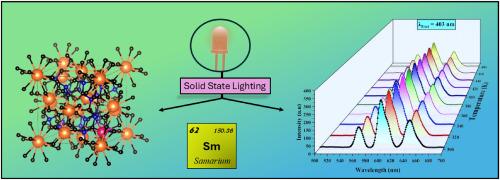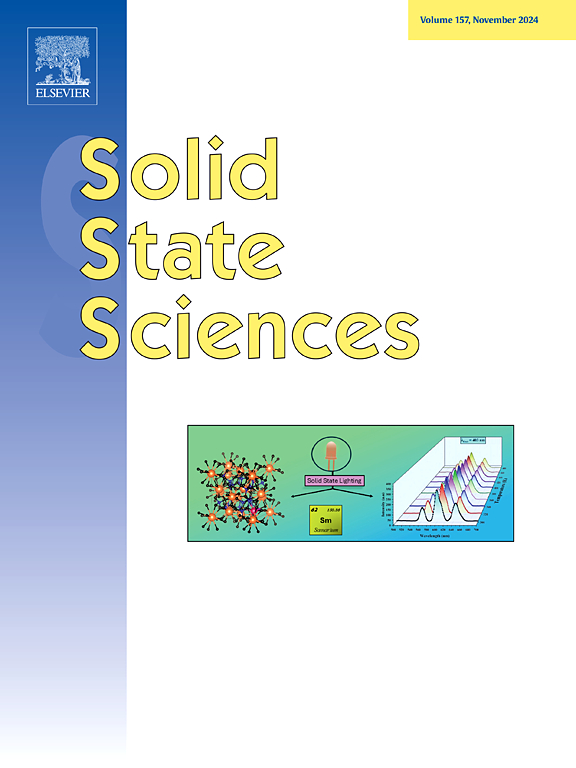Structural, optical, and thermal traits of Sm³⁺-doped SrB₂O₄ phosphors for solid-state lighting applications
IF 3.4
3区 化学
Q2 CHEMISTRY, INORGANIC & NUCLEAR
引用次数: 0
Abstract
We synthesized Sm³⁺-doped SrB₂O₄ phosphors through a solid-state reaction method, varying the Sm³⁺ doping concentrations. Structural and morphological characteristics of material were investigated using Fourier-transform infrared spectroscopy (FTIR), X-Ray Diffraction (XRD) and scanning electron microscopy (SEM). Optical transitions were analyzed by recording the diffuse reflectance spectroscopy, while photoluminescent (PL) spectra were used to evaluate luminescence properties. The PL spectra revealed a strong orange emission at 598 nm under 402 nm excitation. The optimal Sm³⁺ doping concentration was determined to be 0.02 mol, beyond which concentration quenching occurred. This quenching is attributed to exchange-type interactions, which facilitate non-radiative energy relaxation. The CIE color chromaticity coordinates of all the synthesized phosphors fell within the orange region of the chromaticity diagram. Temperature dependent photoluminescence revealed lower activation energy and phonon energy. Thermal quenching temperature was calculated which is inline with commercially available LEDs. All of these results indicate the candidature of SrB2O4 phosphor doped with Sm3+ ions for solid state lighting and optical thermal sensing applications.

用于固态照明的 Sm³⁺ 掺杂 SrB₂O₄ 荧光粉的结构、光学和热学特性
我们通过固态反应方法合成了掺杂Sm³⁺的SrB₂O₄荧光粉,并改变了Sm³⁺的掺杂浓度。利用傅立叶变换红外光谱(FTIR)、X 射线衍射(XRD)和扫描电子显微镜(SEM)研究了材料的结构和形态特征。通过记录漫反射光谱分析了光学转变,而光致发光(PL)光谱则用于评估发光特性。光致发光光谱显示,在 402 nm 的激发下,598 nm 处有强烈的橙色发射。最佳的 Sm³⁺ 掺杂浓度被确定为 0.02 摩尔,超过这一浓度就会出现浓度淬灭。这种淬火归因于交换型相互作用,它促进了非辐射能量弛豫。所有合成荧光粉的 CIE 色度坐标都在色度图的橙色区域内。与温度相关的光致发光显示出较低的活化能和声子能。计算得出的热淬火温度与市售发光二极管一致。所有这些结果表明,掺杂 Sm3+ 离子的 SrB2O4 荧光粉可用于固态照明和光学热感应应用。
本文章由计算机程序翻译,如有差异,请以英文原文为准。
求助全文
约1分钟内获得全文
求助全文
来源期刊

Solid State Sciences
化学-无机化学与核化学
CiteScore
6.60
自引率
2.90%
发文量
214
审稿时长
27 days
期刊介绍:
Solid State Sciences is the journal for researchers from the broad solid state chemistry and physics community. It publishes key articles on all aspects of solid state synthesis, structure-property relationships, theory and functionalities, in relation with experiments.
Key topics for stand-alone papers and special issues:
-Novel ways of synthesis, inorganic functional materials, including porous and glassy materials, hybrid organic-inorganic compounds and nanomaterials
-Physical properties, emphasizing but not limited to the electrical, magnetical and optical features
-Materials related to information technology and energy and environmental sciences.
The journal publishes feature articles from experts in the field upon invitation.
Solid State Sciences - your gateway to energy-related materials.
 求助内容:
求助内容: 应助结果提醒方式:
应助结果提醒方式:


